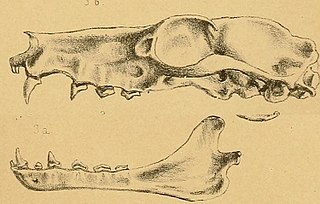
Gadus is a genus of demersal fish in the family Gadidae, commonly known as cod, although there are additional cod species in other genera. The best known member of the genus is the Atlantic cod.

The large-headed capuchin is a species of robust capuchin monkey from South America. It is found in Bolivia, Brazil, Colombia, Ecuador and Peru. It is regarded by some authorities as a tufted capuchin subspecies, Sapajus apella macrocephalus.

The Luzon fanged frog is a species of frog in the family Dicroglossidae. It is endemic to the Philippines.

Tachyoryctes is a genus of rodent in the family Spalacidae. It contains the following species:

The big-headed African mole-rat,, also known as the giant root-rat, Ethiopian African mole-rat, or giant mole-rat, is a rodent species in the family Spalacidae. It is endemic to Ethiopia's Bale Mountains. Its natural habitat is subtropical or tropical high-altitude grassland, where it can reach densities of up to 2,600 individuals per square kilometre. It is threatened by habitat loss. Where the two species overlap, it is the main prey of the endangered Ethiopian wolf.

The Angolan epauletted fruit bat is a species of megabat in the family Pteropodidae. It is found in Angola and Namibia. Its natural habitats are dry savanna and moist savanna. It is threatened by habitat loss.

Atopochilus is a genus of upside-down catfishes native to Africa.
Atopochilus vogti is a species of upside-down catfish endemic to Tanzania where it occurs in the Wami River. This species grows to a length of 12.6 centimetres (5.0 in) TL.
Mormyrus macrocephalus is a species of fish in the Mormyridae family.
Haplochromis macrocephalus is a species of cichlid endemic to the Tanzanian portion of Lake Victoria where it is found in Mwanza Gulf and Speke Gulf. This species can reach a length of 10.6 centimetres (4.2 in) SL.
Atopochilus chabanaudi is a species of upside-down catfish endemic to the Republic of the Congo where it occurs in Stanley Pool. It is consumed for food and is threatened by urbanisation of Stanley Pool, water pollution and lead toxicity which comes from car oil and boat traffic. This species grows to a length of 6.0 centimetres (2.4 in) SL.
Atopochilus christyi is a species of upside-down catfish endemic to the Democratic Republic of the Congo. It occurs in the Ituri, Itimbri and Kasai Rivers as well as the Kinsuka Rapids and Boyoma Falls. This species grows to a length of 9.5 centimetres (3.7 in) SL.
Atopochilus mandevillei is a species of upside-down catfish endemic to the Democratic Republic of the Congo where it occurs in the Kinsuka Rapids. This species grows to a length of 14.1 centimetres (5.6 in) TL.
Atopochilus pachychilus is a species of upside-down catfish endemic to the Democratic Republic of the Congo where it occurs in the Lubilonji River in the vicinity of Kanda Kanda. This species grows to a length of 8.5 centimetres (3.3 in) TL.
Schistura macrocephalus is a species of ray-finned fish. a stone loach, in the genus Schistura. It occurs in riffles over stony or gravel beds in streams with moderate to fast currents in the Mengla River in Yunnan, a tributary of the Mekong, and the Nam Youan in northern Laos, in turn a tributary of the Mengla.

Millerigobius macrocephalus is a species of goby native to coastal waters of the Adriatic Sea, the Levant Sea, the western Mediterranean and the Aegean Sea where it occurs in lagoons and shallow inshore waters to about 4 metres (13 ft) in depth with stones to provide shelter. This species can reach a length of 4.3 centimetres (1.7 in) SL. It is currently the only known member of its genus.

The Caspian tadpole goby is a species of goby which is widespread in the basin of the Caspian Sea, specifically in the near-estuary zone of the rivers and in small bays. It is a common species in the Volga River delta near Astrakhan, occurred in the deltas of rivers Terek, Ural, Samur. During the warmer months, this species prefers to live at depths of from .5 to 10 metres, moving in the colder months to depths of 20 to 25 metres. It can reach a length of 11.6 centimetres (4.6 in) TL.
Dialommus macrocephalus, the Foureye rockskipper, is a species of labrisomid blenny native to the eastern Pacific Ocean from Baja California, Mexico to Colombia. It inhabits the intertidal zone and is capable of leaving the water in search of land-dwelling prey. It feeds on invertebrates including crabs. This species can reach a length of 11 centimetres (4.3 in) TL.
Luciobrama macrocephalus, the long spiky-head carp , is a species of cyprinid fish that is found in China and Vietnam. It is the only member of its genus,and is claasified as Data Deficient by the IUCN. It is found in rivers and lakes. Larger fish, over 30 centimetres (12 in) live nearer the bottom and the smaller specimens are found higher in the water column. They are partially migratory. It has not been recorded from its spawning sites since 1988.
Alcichthys elongatus is a fish in the family Cottidae (sculpins), and the only valid member of its genus. It was described by Franz Steindachner in 1881. It is a marine, boreal fish which is known from the northwestern Pacific Ocean, including the Sea of Okhotsk and Japan. It dwells at a depth range of 15 to 269 m, and inhabits rocky reefs. Males can reach a maximum total length of 44 cm (17 in), but more commonly reach a TL of 31.5 cm (12.4 in). The maximum recorded weight is 1 kg (2.2 lb).













